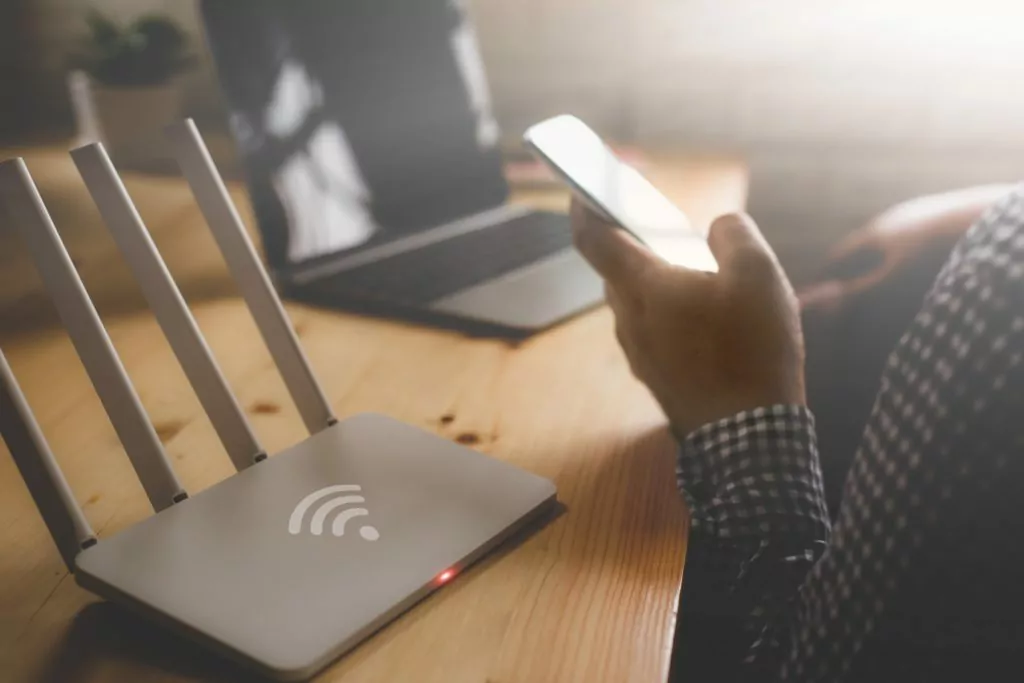This is how to get the Wi-Fi password of the network you’re connected to via LAN.
You’re connected to a network via LAN and want to connect your phone, for example?
So if you want to know how to get the Wi-Fi password of a network, you’re in the right place.
Let’s jump right in!

Get the WI-FI Password of a Network You Are Connected to via LAN
Wherever we sit, we ask for a password because we want to connect to the internet.
Bars, pubs, restaurants, cafes, public parks, Wi-Fi is everywhere.
It’s everywhere because we are curious. It’s in our nature. We want to know everything about anything, and the internet is a ubiquitous source of information.
Now, we do have data plans from our service providers that give us data, and we can surf the internet easily. However, sometimes we need to do something on our laptops while commuting or simply sitting in a bar.

When it’s urgent, we need to finish it. What better way to do it than by asking the waiter for the Wi-Fi password and connecting to the internet? We wouldn’t want to waste our data plan.
What happens when we’re sitting at the office, and our computer is connected to the internet via LAN (local area network) cable?
We have an internet connection on our computer, but we also want to connect to the Wi-Fi network with our phone.
How can we get the Wi-Fi password of the network we are connected to via LAN cable?
Let’s first get to know what LAN is and learn a little about how it works.
Let’s get started!
The Meaning of LAN
The word LAN is used daily in offices, and it’s almost synonymous with the word “cable.” When we speak about LAN, we speak about the local area network.
This type of network is common for households, campuses, offices, etc. It connects computers within a short distance of each other.
The two most frequent ways to connect devices to this type of network are:
- Ethernet: a cable connection that we usually use to connect our desktop computers to routers for internet access. It’s also faster than a Wi-Fi connection because it goes through a cable instead of radio waves.
- Wi-Fi: spreads radio waves in different frequencies to provide a connection between devices and internet access. It’s much more convenient because we won’t get tangled up in all those cables. It is also called WLAN (wireless LAN).
Wireless local area networks are the most popular connection and internet access method in homes and commercial establishments. They are easy to install and use, and that’s why they are so common.
What about their security?
Are they secure enough?
Why Wi-Fi Password?
There are three reasons why Wi-Fi passwords exist. They prevent others from accessing your home network. They prevent hackers from viewing your traffic, and they prevent bandwidth theft.
We commonly create the Wi-Fi password on our private network to stop other people, such as other tenants in the building, neighbors, or their guests, from accessing our internet connection.

It’s only logical. One of the main reasons our internet speed might be slow is because there is an overload.
It can happen from too many apps siphoning the internet. It can happen because too many devices are connected to the same network that can’t support them all.
Imagine having a straw drinking contest with a couple of friends where you drink with straws from the same punch bowl. You all start drinking at the same time, and the punch quickly disappears.
This happens with the Wi-Fi network as well. Too many connected devices result in a sketchy connection where you know that you are connected. Still, it seems like there’s no internet at all.
The other most important reason is the hackers. We need a wireless password because we want to protect ourselves from malicious attacks and spy on our internet traffic.
Our internet traffic is everything that we do online. This is something that should remain in the privacy of our homes, not in the hands of someone we don’t know.
When a Wi-Fi Password Gets Forgotten…
Every once in a while, it just so happens that we buy something new when it comes to technology. Whether it’s an upgrade as a smartphone or a new laptop, we want to connect it to WLAN.
Now, since every device in the house is already connected to the network, and all your guests had used the password when they were over, it’s only natural that you might have forgotten it.
So, the question is, how do we recover it?
Where can we find it?
Getting the Wi-Fi password from the router
Like everything that we do, connecting to a wireless network leaves tracks as well. You can easily find the password if you’re already connected to your WLAN.
The easiest way to know your Wi-Fi password is if you haven’t changed it since you’ve installed the wireless router.
A wireless router is a device that you can connect to via Ethernet cable or Wi-Fi. It gives you access to the internet.
With it, everything we do on the internet is possible. Without it, it would be fairly difficult to connect.
When we look at the wireless router, we can see the default network security key.

If you haven’t changed it since you’ve installed it, you’re in luck. Just type it in, and you’ll be connected.
However, suppose you changed it at some point and forgot it. In that case, you can always use the router’s IP (internet protocol) address and a wired connection.
The IP address is a unique address of any device connected to a network.
Suppose you connect a laptop or computer to the router using an Ethernet cable (LAN cable). In that case, you can easily recover your Wi-Fi password.
Just follow these simple steps:
- Make sure that the device has an internet connection through a cable.
- Take a look at the router (the other device the cable is connected to) and see if it has an IP address on it, e.g., 192.168.0.1
- Type the IP address in the browser (Google Chrome, Mozilla Firefox, Edge, etc.) on the connected computer and hit “Enter.”
- You will see the main page of your router’s controls and settings. There will be a login page.
- If you’ve never done this, the default username will usually be “admin,” and the password may be nothing or also “admin.”
- Once logged in, click on “setup,” and then click on “wireless settings.”
- You’ll see an option to click “manual wireless setup.” When you click on that and scroll to the bottom, you should see your Wi-Fi password, or you can simply change it.
The Wi-Fi password can be under different names, WEP (Wireless Equivalent Privacy) key or WPA (Wi-Fi Protected Access). It’s more or less the same, as it is a password that keeps your internet access protected.
There are also other ways you can access your Wi-Fi password.
Where is the Wi-Fi password stored in Windows 10?
In Windows 10, we can find the password in “wireless properties.” We do it by going to the control panel, network and internet, and network and sharing.
If you’re connected to the wireless network, you’ll be able to see it in the network and sharing center.
After clicking on it, a window will pop up, and you’ll be able to click on the “wireless properties” button and simply go to the “security” tab.
Voila, you can now see the password. Just make sure to tick the “show characters” box.
The other sure way we can see the Wi-Fi password is by accessing all the saved Wi-Fi profiles in Windows 10. It’s fairly easy as well.
Follow these steps:
- Click on the windows key, and type in “run.” An app will appear under the best match.
- Click on it, type in “cmd” and hit the “enter” key.
- A black window will pop up.
- You should type in “netsh wlan show profiles” and hit the “enter” key.
- A couple of lines of text will appear where you’ll be able to see all the wireless network profiles saved on your device.
- Type in “netsh wlan show profile name=theNameOfTheConnection key=clear”.
- Press “enter,” and you’ve got it. You’ll be able to see your Wi-Fi password under the “security settings” information.
The netsh (network shell) command is something available in all Windows systems starting from Windows 2000. It allows us to remotely configure networks. But, this can be somewhat complicated.
Sometimes, it’s just easier to copy the password from another device like an android phone. But, how do you find it?
Where Is The Wi-Fi Password Saved on Android?
Pretty much all Android phones have similar features. The only thing that you’d need to do is access the settings on your android phone.
Go to the connection settings. Go to the Wi-Fi settings, and you’ll be able to see the wireless network you are connected to.
Tap that network name, and in the bottom left corner, you’ll find the QR code option. Tap it, and use another device’s QR scanner to read it, and you’ll be able to see the Wi-Fi password.
There are many tools online that promise Wi-Fi password recovery or simply reveal it to you.
The mentioned ways for figuring out Wi-Fi passwords are the most secure ones because you don’t have to install any additional software.
If all of these fail somehow, there’s always the final option we can try.
Wi-Fi Password Reset
We can call our internet service provider and ask for a factory reset of the settings. Find the contact number for customer service of your internet provider and call them. They’ll resolve the issue easily.
Plus, they can give you the password straight away if they have access to it, or they can simply reset it.
When our internet service provider does a factory reset, it immediately brings everything to the way it originally was.
You’ll be able to access the Wi-Fi connection by using the same wireless network name and password you first used.

